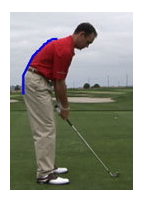In a previous post titled “Stand Right So You Don’t Hit Right” we discussed how setting up in C-Posture at address can be detrimental to both your swing and back health. To review, C-Posture is when one rounds their shoulders and mid-upper back (thoracic spine) to address the ball as opposed to bending forward from their hips. This limits the amount of space the spinal joints have to rotate. As a result, a golfer that sets up in C-Posture tends to lose their posture within their swing with much more regularity than one that sets up in a neutral position.
More often than not, correcting C-Posture is a tougher fix than simply pulling the shoulders back and straightening out the spine. One common cause of C-Posture stems from a condition called upper crossed syndrome. Simply defined, crossed syndrome occurs when one or more muscle groups are overly tight while their opposing muscle groups are weak or inhibited. In upper crossed syndrome, the pectoralis muscle group (chest muscles) is overly tight while the scapular muscle group (shoulder blade/mid-back muscles) is weak or inhibited. We commonly find that those with upper crossed syndrome are the same people that sit in a desk slouched over (in C-Posture!) for the majority of the day. This is a habit that is formed over numerous years of schooling and sedentary working and proves very difficult to break.

In order to improve posture at address by correcting upper crossed syndrome, training must be aimed with the goal of regaining flexibility in the chest, and strengthening the scapular stabilizer muscles in the mid-back. One great stretch to gain flexibility in the chest is the swiss ball chest stretch. To perform this stretch, grab a large swiss ball and position yourself by sitting on the ball. From here, walk yourself away from the ball until your mid-back and head are the only two things supported. Press your hips up and keep them in line with your shoulders. Now bring your shoulders and elbows to 90 degrees and press the back of your elbows and hands towards the floor. In this position you should feel a good stretch across your chest muscles and the front of your shoulders. Hold for about 60 seconds for 1-2 repetitions.
In conjunction to keeping the front muscles in your chest loose, you must also strengthen the scapular stabilizer muscles of the mid-back. One simple exercise to do this is called the reach, roll, and lift. To begin, position yourself by kneeling down on the ground and sitting back onto your heels. Place both arms up on a swiss ball then take your right arm and reach out as far as possible over the ball and keep your trunk stable. Roll your palm over so it’s facing the ceiling and lift your arm up from the ball. Make sure your palm does not roll back over towards the floor and lift your arm only. Your shoulder and trunk should not elevate and extend. Do at least 2 sets of 10 repetitions for each arm.
Let me know if you have and questions or need any help with this stuff.
Jason
If you try these exercises and you find them to be too challenging or uncomfortable, do not continue, until you have consulted with your physician. All exercises for golf should be customized to your needs after a proper evaluation.
Come In and See Us
Want to take your golf to the next level? Our FitGolf® Trainers are experts at working one-on-one with you to tailor a training program to meet the specific needs of your body and help you achieve the results you are hoping to see in your golf.
Want More Resources?
Looking for more exercise resources, blog posts or monthly golf-specific exercise content sent straight to your inbox?
